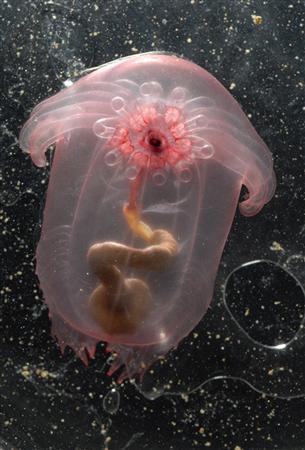Dark Ocean Depths Home To Exotic, Unknown Life
Country: NORWAY
Author: Alister Doyle

A transparent sea cucumber, identified as
Enypniastes, is seen at a depth of 2,750 meters (9,200) in the
northern Gulf of Mexico in this undated handout photo released
November 22, 2009.
Photo: Larry Madin/Handout
OSLO - The permanent darkness of the ocean depths is home to a far greater range of animals, from luminous jellyfish to tubeworms that live off oil seeping from the seabed, than previously thought, scientists said on Sunday.
A total of 17,650 species of animals, also including shrimps, corals, starfish or crabs, have been identified in the frigid, sunless waters down to about 5 km (3 miles) deep.
"The diversity of life in the deep sea is much, much greater than we've believed," said Robert Carney of Louisiana State University, who co-leads a study of the ocean depths as part of a wider international Census of Marine Life (COML).
"The abyss is not the dark hole any more," he told Reuters of surveys with deep-towed cameras, sonar's and other technology.
Light typically penetrates about 200 meters into the seas -- comparable to the height of the 169-meter Washington Monument obelisk -- and the zone beyond has long been viewed as a desert with crushing pressures.
Beyond the sunlit area where plants can grow, creatures have to exploit bacteria, for instance that break down methane or oil, or food falling from the surface such as whale carcasses.
Among creatures were luminous jellyfish and gelatinous creatures known as finned octopods, or "Dumbos" because they flap ear-like fins and look like the cartoon flying elephant.
Dumbos, about two meters long, are among the big creatures of the abyss, also including some sharks or siphonophore jellyfish, Mike Vecchione, of the Smithsonian Institution, said.
"Siphonophores have been reported to be longer than a blue whale," he told Reuters. The Census of Marine Life is a 10-year project due for completion in October 2010.
OIL DRILLING
In one part of the Gulf of Mexico, experts found a tubeworm at 990 meters deep on the seafloor. When a robotic arm lifted it from a hole on the seabed, oil gushed out -- it was consuming chemicals from decomposing oil.
Carney said that oil companies focused most on geological surveys to find deposits but that the presence of tubeworms could also be a marker. "You certainly have a source or methane or liquid petroleum nearby if you find these tubeworms," he said.
Still, Carney said many scientists were "bothered by the prevalence of the view that the deep sea is of no concern" and that a drive to exploit resources was getting ahead of knowledge of the depths and the creatures that live there.
Little is known about them. Only seven of 680 specimens of tiny crustaceans known as copepods recently collected in the southeastern Atlantic could be identified. Another trip found the Antarctic's first recorded whalebone-eating worm, Osedax.
Although the ocean depths are permanently black, many animals create their own light -- with luminous markings to help spot or attract prey or a mate -- and have working eyes.
A few creatures visit the abyss from the sunlit zone -- one southern elephant seal was registered at a depth of 2,388 meters.
Global warming, stoked by human activities such as burning fossil fuels, may also be affecting the frigid depths. "There is evidence of both warming in some deep ocean areas and increasing acidification," Vecchione said.
© Thomson Reuters 2009 All rights reserved
